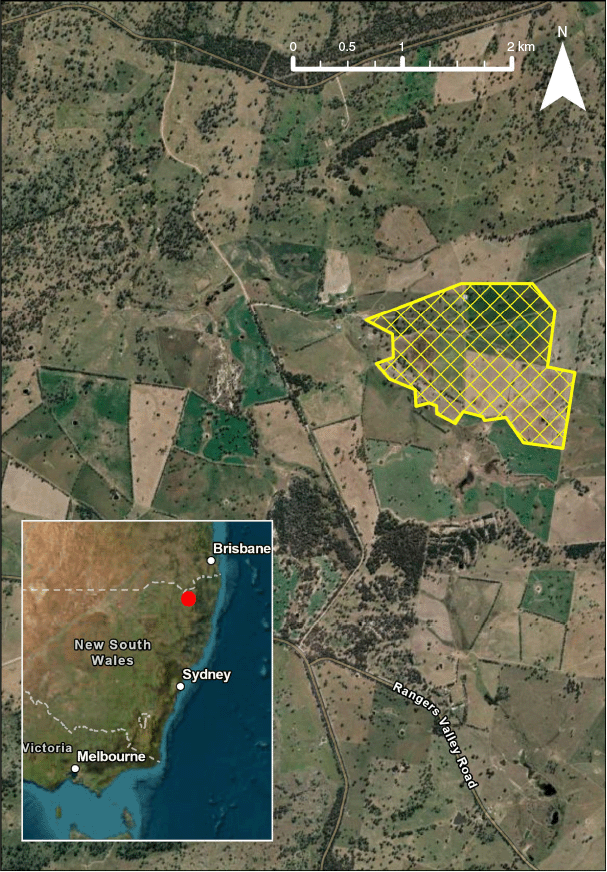Local high concentration of Red Foxes (Vulpes vulpes) observed during lambing in northern New South Wales, Australia
Deane A. Smith A B * , Thomas Coldham C and Paul D. Meek B DA
B
C
D
Abstract
A local high concentration of red foxes (Vulpes vulpes) was observed over a single night in response to a lambing event in northern New South Wales (NSW), Australia. A total of 21 foxes were shot over 1 h within a 1.4 km² area, highlighting the strong attractant effect of lambing on local fox populations. Additionally, the control effort resulted in the removal of 11 more foxes over the following 5 days. These observations provide insight into the local abundance and scavenging behaviour of foxes, with potential implications for livestock management, predator control strategies and local ecology.
Keywords: fox control, lambing event, livestock predation, pest management, predator aggregation, predator ecology, red fox, scavenging.
Introduction
The red fox (Vulpes vulpes; hereafter ‘fox’) is an invasive predator in Australia, where it poses a significant threat to both native wildlife and agricultural operations (Saunders et al. 1995; Saunders and McLeod 2007). Since its introduction in the 19th century, the species has expanded its range across much of the continent, exploiting a variety of habitats and food sources. Foxes are particularly problematic for sheep producers, as they are known to prey on lambs and scavenge afterbirth during lambing periods.
Lambing events create a concentrated and predictable source of food, potentially drawing in foxes from surrounding areas. While fox presence on agricultural land is well-documented, there are limited documented reports on fox densities in response to ephemeral food resources. Understanding the extent of fox aggregation at lambing sites is important for developing effective management strategies aimed at reducing predation and mitigating economic losses for farmers.
Here, we report an unusually high number of foxes removed during a shooting program in a small area during a lambing event. Our findings contribute to the broader understanding of fox behaviour in agricultural landscapes and underscore the importance of targeted management practices prior to vulnerable periods for livestock (Greentree and Saunders 2000; Greentree et al. 2000).
Methods
On the night of the 24th of May 2023, over a 1-h period, foxes were shot within a 1.4 km² area surrounding a lambing site near Emmaville, NSW, Australia (29°27′03.9″S 151°41′28.2″E; pers. comm. Coldham et al. 2025) in response to observed high numbers in the area. No other fox control actions were undertaken at the time (i.e. fox baiting); however, opportunistic shooting did take place in the lead up to the control events described – but these were not recorded. The foxes were drawn to the site, likely attracted by the availability of afterbirth and the presence of vulnerable lambs. The management action was conducted using a thermal rifle mounted scope, and a thermally assisted spotter. Each kill was confirmed and tallied by the spotter, and carcasses were left in situ. This was done as part of routine control undertaken by the land manger to discharge their biosecurity duty under the Biosecurity Act (2015) and in line with the Northern Tablelands Regional Strategic Pest Animal Management Plan (NSW Local Land Services 2018). Two additional nights (~1 h each) of control over the following 5 days were conducted within the same 1.4 km2 area (Fig. 1). All control was undertaken with a .223 rifle.
Location of the high concentration of foxes observation. Hashed area shows the 1.4 km2 area where control activities were undertaken in relation to road infrastructure and land coverage. The inset map shows the broader context of the location, with the red dot indicating the location of the foxes observation.

Results
During the first night of shooting, a total of 21 individual red foxes were culled. Over the two additional nights of targeted control, an additional 11 foxes were removed, bringing the total number of individuals culled over a five-night period to 32. Based on the area in which foxes were encountered and actively managed during the initial night, the estimated number of foxes present equates to at least 15.06 individuals/km2. When considering the entire week of management efforts and the total area covered, 22.86 foxes were culled per km2. This also equates to a rate of approximately 10.7 foxes/h of active control.
Discussion
This observation suggests that lambing events can act as strong attractants for foxes, leading to temporarily elevated local densities. The high number of individuals recorded in a small area suggests that fox populations may be higher than previously estimated, or that such events cause foxes to travel from surrounding areas, contrary to our understanding of fox ecology. The presence of 21 foxes in a single night, followed by the removal of 11 more, underscores the potential predation and scavenging pressure foxes exert on sheep farming operations.
This observation recorded a local concentration of foxes double that of the purported maximum density calculated at the national scale of 7.2/km2 (Saunders et al. 1995; West 2008), and on par with the highest calculated density of foxes (16/km2) in an Australian city (Marks and Bloomfield 1999). The concentration of foxes recorded here is also double that recorded for the Glen Innes district (~15 km south of the site) in the early 1990s (4.55–7.16 foxes/km2; Thompson and Fleming 1994). Given the method of control may have left foxes undetected, and the lambing event likely drew foxes from outside the 1.4 km2 site, 15.06 foxes/km2 is a rough estimate and should not be compared to densities of foxes reported from more robust methods.
Further studies should investigate the movement patterns of foxes from the broader landscape in response to lambing events to improve control measures and mitigate economic losses for farmers. Aggregations like those reported are unusual, with foxes commonly known to occupy defined home range areas and defending their territory (Macdonald 1987) with high densities more often associated with foxes in cities (Harris and Smith 1987). Aggregations challenge the ecological knowledge of fox activity and behaviour in response to home ranges/activity areas. The high concentration of foxes observed at this lambing event highlights the need for strategic fox control (baiting and supplementary shooting) prior to lambing (Greentree and Saunders 2000) and during, to reduce the potential for these aggregations to impact on lamb survivorship.
Data availability
All data is presented. Please contact the corresponding author for any needed clarification.
Acknowledgements
The authors would like to thank Charlie Coldham and Simon Sharman for their contributions, information and the data they provided on the fox control effort.
References
Biosecurity Act (2015). Department of Agriculture, Fisheries and Forestry. Retrieved from https://www.legislation.gov.au/C2015A00061
Greentree, C., Saunders, G., Mcleod, L., and Hone, J. (2000). Lamb predation and fox control in south-eastern Australia. Journal of Applied Ecology 37(6), 935-943.
| Crossref | Google Scholar |
Harris, S., and Smith, G. C. (1987). Demography of Two Urban Fox (Vulpes vulpes) Populations. Journal of Applied Ecology 24(1), 75-86.
| Crossref | Google Scholar |
Marks, C., and Bloomfield, T. (1999). Distribution and density estimates for urban foxes (Vulpes vulpes) in Melbourne: implications for rabies control. Wildlife Research 26(6), 763-775.
| Crossref | Google Scholar |
NSW Local Land Services (2018). ‘Northern Tablelands Regional Strategic Pest Animal Management Plan [2018 - 2023].’ (Northern Tablelands Local Land Services.) Retrieved from https://www.lls.nsw.gov.au/
Saunders, G., Coman, B., Kinnear, J., and Braysher, M. (1995). Managing Vertebrate Pests: Foxes. (Canberra, ACT: Australian Government Publishing Service.) Retrieved from https://pestsmart.org.au/
Thompson, J., and Fleming, P. (1994). Evaluation of the Efficacy of 1080 Poisoning of Red Foxes using Visitation to Non-toxic Baits as an Index of Fox Abundance. Wildlife Research 21, 27-39.
| Crossref | Google Scholar |
West, P. (2008). Assessing invasive animals in Australia 2008. (National Land & Water Resources Audit.) Available at https://www.pestsmart.org.au/assessing-invasive-animals-in-australia-2008/


